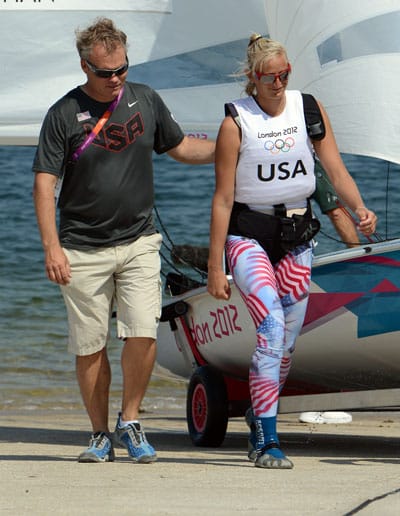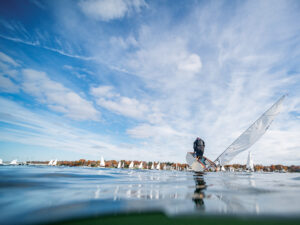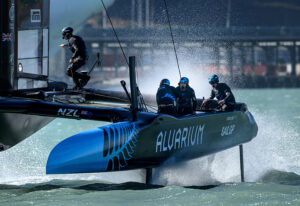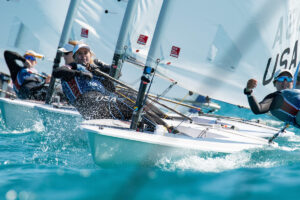
120813_Andreasen_Lihan
The first step for anyone looking to find the reason behind the U.S. Sailing Team Sperry Top-Sider’s dismal performance at the 2012 Olympics (no medals, just one top-five finish) is this: take a deep breath.
In fact, that’s probably steps two through 10 as well.
OK, with that out of the way, let’s move forward by looking at some of the most pressing questions hovering around this regatta.
Was it really that bad?
Olympic Sailing, as we know it, basically started with the 1948 London Games. Prior to that the classes were fairly haphazard, and often drew just a few entries. In some cases, just one boat showed up, and went home with a gold for its efforts. From 1948 on, the Olympics has had a fairly logical slate of classes, expanding gradually from five in 1948 to 10 in 1992. Until this year, the U.S. had scored at least two medals in every Olympics, not including the Moscow Olympics in 1980, which the United States and many other nations boycotted. The U.S. Sailing Team failed to win at least a single gold in only three of those 15 Games.
Prior to 2012, the worst U.S. performance was in 1996, when the team scored just two bronzes. Relative to pre-regatta expectations, that was probably a bigger disappointment as the U.S. Sailing Team had hoped to contend in nearly all 10 classes. For 2012, the U.S., based on pre-event results, was a legitimate medal contender in just three classes: Finn, Laser Radial, and Women’s Match Racing. The team had an outside chance in a few others (Star, Women’s 470, 49er), though only Mark Mendelblatt and Brian Fatih in the Star had ever produced a top-three finish at a class world championship. The Men’s 470 duo (Stu McNay and Graham Biehl) had a great world ranking (fifth as of late June) but had never finished higher than 10th in a world championship. A medal would’ve represented a big leap. In the Laser and the RS:X classes, recent results gave the U.S. no realistic chance at a medal.
France and the United States were two of the three countries to enter an athlete or team in all 10 classes. France came home with just one medal, a bronze in the Finn, and that was largely due to Dutch Finn sailor Pieter-Jan Postma taking an ill-advised gold-or-nothing risk in the closing moments of the medal race. Had he acted more conservatively, France would’ve gone home with nothing. Brazil scored just one bronze, from Olympic superstar Robert Scheidt and Bruno Prada in the Star.
Germany, Italy, and Canada each entered eight of the 10 classes and, like the United States, were shut out. In sum, 47 nations, of 63 that competed in Weymouth, went home without a medal.
In other words, winning Olympic sailing medals is both hard and rare. You could say it’s always been this way, but it’s gotten progressively harder with each Olympics. Getting shutout isn’t acceptable for the U.S. Sailing Team, but anyone who acts like they can’t believe it happened hasn’t been paying attention, or is using the opportunity to bash the establishment.
OK, that’s fine, but you said we’d contend in three classes; what went wrong?
That’s a good question. If there was a common thread among the U.S. sailors, it was that they never felt in sync with the shifts. The breeze was from a standard direction, but wasn’t the typical southwest sea breeze, according to Brenner. It was shiftier than normal, especially on the Nothe and Portland Harbour courses. Of course, this was the same for everyone, and many of the other favorites did fine in these “abnormal” conditions. Additionally, speed can make you look very smart. The lack of it can make you look consistently out of phase. Where Finn silver medalist Jonas Hoegh-Christensen had little trouble working through the fleet after a bad start, Zach Railey could not. Railey maintained that he made too many bad decisions early in the event and had to gamble too much in the second half. I have no reason to second-guess him, but he didn’t seem to consistently have the same speed as the top five finishers in the Finn fleet. Bear in mind that at the Skandia Sail For Gold, on the Olympic site in June, Railey finished fourth, Hoegh-Christensen, 12th.
Paige Railey’s struggles were not limited to the Games. After finishing third in a fairly light-air world championships in Fremantle, Australia, last December, Railey couldn’t find her form in 2012. She was 11th, ninth, and 13th in her three major spring tune-up regattas. In her final interview she mentioned she’s already looking ahead for 2016, and will be working on a program to prevent her from getting “stale.” Perhaps that was behind her slump in 2012. After all, she’s been sailing the Radial on an international level for nearly a decade, and she rarely sails anything else.
Bad luck is also at fault. The best U.S. team in breeze, the Women’s 470 duo of Amanda Clark and Sarah Lihan, sailed in the lightest conditions. In Women’s Match Racing, two bad shifts can end a regatta. And this is what happened to Anna Tunnicliffe and her team in the quarterfinals. Recovering from two missed shifts happens all the time in a fleet race, let alone an entire regatta. But that’s match racing. Three of the favorites—France, Great Britain, and the United States—fell in the quarterfinals.
The most distressing thing about the U.S. team is that all of the sailors—the RS:X sailors excepted—finished the Olympics either below their current ISAF world ranking or worse than their finish at the 2011 ISAF Combined Worlds in Fremantle, Australia, last December. In some cases they did both.
Four years ago, current head coach Kenneth Andreasen was able to perfectly prepare Zach Railey for the Qingdao Olympics, and then get him to sail the regatta of his life. But his ability to get athletes to peak didn’t translate to these Games. That’s a worry.
Who’s to blame? Who can we fire?
In the wake of the 2012 Games, the U.S. team closed ranks, offering only Brenner for interviews. (The team rebuffed my request to speak with Andreasen after the Games, which is a strange decision since he is the team’s head coach.) Brenner, as chairman of U.S. Sailing’s Olympic Sailing Committee, which is now a paid position, fell on the grenade, so to speak. He’s retiring, so whether he’s at fault or not, he won’t be running the show for the next quadrennium. That will fall to his successor, Josh Adams, who will now be the full-time managing director of the team.
Brenner said he was very pleased with the performance of the USST coaches, but added that everyone will get a thorough review. From what I’ve seen of Andreasen, I think he’s the right person for this job. And he’ll surely learn from this experience. His supporting staff will need some change, however. There’s just no way they can look at these results and then bring back the same set of coaches. New blood is needed. If the Star is indeed brought back in for Rio then Mark Ivey, a former U.S. Sailing Team coach, and the man who helped Freddie Lööf finally get his gold medal, should be seriously considered to coordinate the team’s effort in that class. American Morgan Reeser, the Men’s 470 coach for Great Britain and a 1992 silver medalist in the class, would be a great asset as well, especially since the U.S. 470 squad may undergo wholesale change, and technical expertise can help young sailors quickly climb the ladder. With his track record, however, he isn’t likely to come cheaply.
To read Part II, click here.









